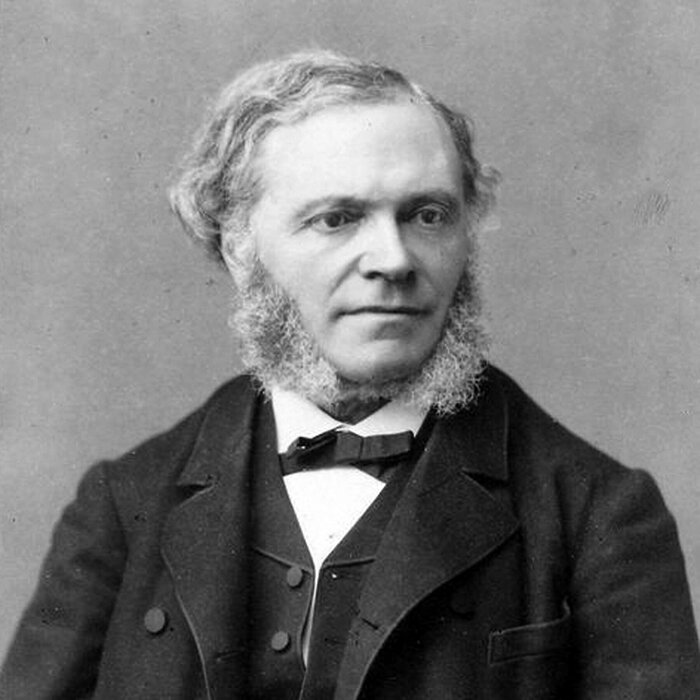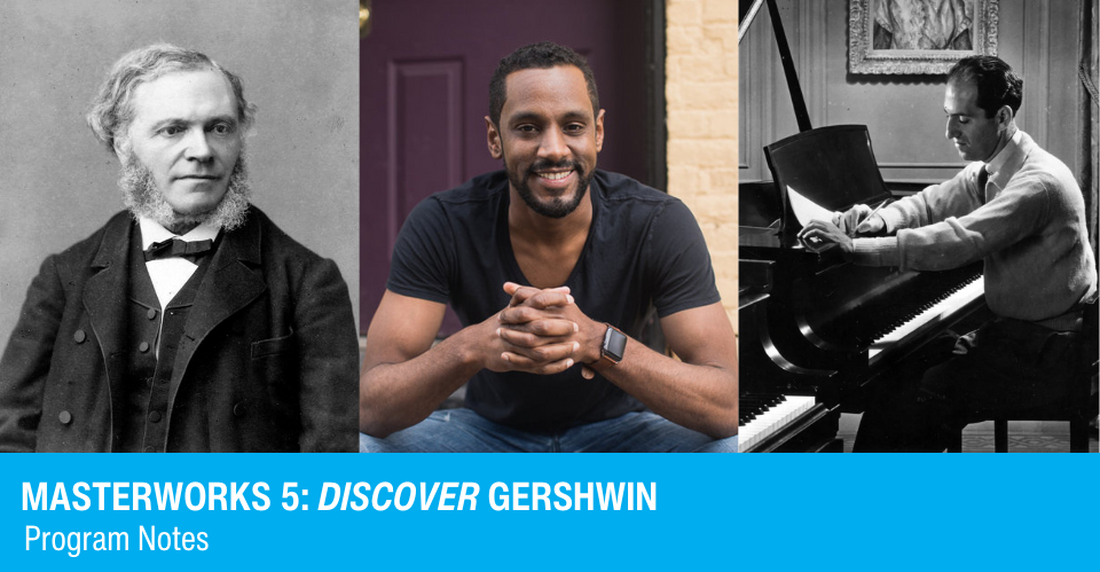30 SECOND NOTES: The first half of this Des Moines Symphony program celebrates two aspects of the American musical experience. Carlos Simon, Kennedy Center Composer-In-Residence, was born and raised in Georgia, where his life was formed around his father’s church. “Amen!,” Simon wrote, “is intended to re-create the musical experience of those African-American Pentecostal Church services.” A century earlier, George Gershwin’s Rhapsody in Blue “made a lady out of jazz,” according to conductor Walter Damrosch. The 100th anniversary of that epochal event is observed on this program. The balance of the concert is devoted to César Franck’s Symphony in D Minor, a masterpiece of French music.

Carlos Simon
- Born April 13, 1986 in Atlanta, Georgia
AMEN!
- First performed on November 21, 2017 by the University of Michigan Symphonic Band, conducted by Michael Haithcock.
- These concerts mark the first performances of this piece by the Des Moines Symphony.
(Duration: ca. 13 minutes)
Carlos Simon, Kennedy Center Composer-In-Residence through 2024, was born in Atlanta in 1986 and grew up playing organ at his father’s church, immersed himself in music in high school, earned degrees from Georgia State University and Morehouse College, and completed his doctorate at the University of Michigan, where he studied with Evan Chambers and Grammy-winning composer Michael Daugherty. Simon also studied in Baden, Austria and at the Hollywood Music Workshop and New York University’s Film Scoring Summer Workshop. He taught at Spelman College and Morehouse College in Atlanta before being appointed in 2019 to the faculty of Georgetown University, where his projects include a new composition dedicated to the slaves who helped build the school. Simon has composed works for orchestra, chamber ensembles, solo voice, chorus, concert band and film, several of them on commissions from such noted organizations as the New York Philharmonic, Los Angeles Philharmonic, Los Angeles Opera and Philadelphia Orchestra. He has also performed as keyboardist with the Boston Pops, Jackson Symphony and St. Louis Symphony, toured Japan in 2018 under the sponsorship of the United States Embassy in Tokyo and US/Japan Foundation performing in some of the country’s most sacred temples and important concert venues, served as music director and keyboardist for Grammy Award-winner Jennifer Holliday, and appeared internationally with Grammy-nominated soul artist Angie Stone. Simon received the 2021 Medal of Excellence of the Sphinx Organization, which is dedicated to promoting and recognizing Black and Latinx classical music and musicians. His additional honors include the Marvin Hamlisch Film Scoring Award, Theodore Presser Foundation Award, ASCAP’s Morton Gould Young Composer Award, fellowships from the Sundance Institute and Cabrillo Festival for Contemporary Music, and a residency at the 2021 Ojai Festival.
Simon wrote, “Amen! was commissioned by the University of Michigan Symphonic Band in celebration of the University’s 200th anniversary in 2017; it was premiered on November 21, 2017 at Hill Auditorium. The orchestral arrangement was commissioned in 2019 by the Reno Philharmonic, Gateways Music Festival and American Composers Orchestra. Amen! is a homage to my family’s four-generational affiliation with the Pentecostal Church. My intent in Amen! is to re-create the musical experience of the African-American Pentecostal Church services that I enjoyed being a part of while growing up in this denomination.”
The score calls for piccolo, two flutes, two oboes, English horn, two clarinets, two bassoons, four horns, three trumpets, three trombones, tuba, timpani, bass drum, cymbals, snare drum, glockenspiel, triangle, tam-tam, piano, and the usual strings consisting of first violins, second violins, violas, violoncellos and double basses.

George Gershwin
- Born September 26, 1898 in Brooklyn, New York;
- died July 11, 1937 in Hollywood, California.
Rhapsody in Blue for Piano & Orchestra
Orchestrated by Ferde Grofé
- First performed on February 12, 1924 in New York, conducted by Paul Whiteman, with the composer as piano soloist.
- First performed by the Des Moines Symphony on March 16, 1947 with Frank Noyes conducting and Jesús María Sanromá, pianist. Six subsequent performances occurred, most recently on May 19 & 20, 2018 with Joseph Giunta conducting and Charlie Albright as soloist.
(Duration: ca. 18 minutes)
For George White’s Scandals of 1922, the 24-year-old George Gershwin provided something a little bit different — an opera, a brief, somber one-acter called Blue Monday (later retitled 135th Street) incorporating some jazz elements that White cut after only one performance on the grounds that it was too gloomy. Blue Monday, however, impressed the show’s conductor, Paul Whiteman, then gaining a national reputation as the self-styled “King of Jazz” for his adventurous explorations of the new popular music styles with his Palais Royal Orchestra. A year later, Whiteman told Gershwin about his plans for a special program the following February in which he hoped to show some of the ways traditional concert music could be enriched by jazz, and suggested that the young composer provide a piece for piano and jazz orchestra. Gershwin, who was then busy with the final preparations for the upcoming Boston tryout of Sweet Little Devil and somewhat unsure about barging into the world of classical music, did not pay much attention to the request until he read in The New York Times on New Year’s Day that he was writing a new “symphony” for Whiteman’s program. After a few frantic phone calls, Whiteman finally convinced Gershwin to undertake the project, a work for piano solo (to be played by the composer) and Whiteman’s 22-piece orchestra — and then told him that it had to be finished in less than a month. George thought that he could complete the short score in time, but, since he was unfamiliar with the techniques of writing for instrumental ensemble, he asked that Whiteman’s arranger, Ferde Grofé (whose greatest fame came as composer of the 1931 Grand Canyon Suite), do the orchestration.
Themes and ideas for the new piece immediately began to tumble through Gershwin’s head, but it seems that the vision of the work’s finished form did not appear until he was on a train to Boston for the tryouts of Sweet Little Devil: “It was on the train, with its steely rhythms, its rattlety-bang that is often so stimulating to a composer.... I frequently hear music in the very heart of noise. And there I suddenly heard — and even saw on paper — the complete construction of the Rhapsody, from beginning to end. No new themes came to me, but I worked on the thematic material already in my mind and tried to conceive the composition as a whole. I heard it as a sort of musical kaleidoscope of America — of our vast melting pot, of our unduplicated national pep, of our blues, our metropolitan madness. By the time I reached Boston, I had a definite plot for the piece, as distinguished from its actual substance.” Late in January, only three weeks after it was begun, Gershwin completed the Rhapsody in Blue, except for some solo piano figurations. “I was so pressed for time,” he wrote, “that I left them to be improvised at the first concert. I could do that as I was to be the pianist.” Grofé completed the orchestration on February 7th.
The premiere of Rhapsody in Blue — New York, Aeolian Hall, February 12, 1924 — was one of the great nights in American music. With this concert, billed as an “Experiment in Modern Music,” Whiteman wanted to demonstrate both the historical development of jazz as a particularly American phenomenon and the manner in which the jazz style might be utilized in modern concert compositions. The program included piano solos by Zez Confrey (notably his Kitten on the Keys), arrangements for the full orchestra of such pop tunes as Alexander’s Ragtime Band and Limehouse Blues, examples of various jazz treatments of well-known songs, a Suite of Serenades by Victor Herbert, and, as the center piece for the evening, Gershwin’s Rhapsody in Blue. Many of the era’s most illustrious musicians attended, including Mischa Elman, Fritz Kreisler, Jascha Heifetz, Moriz Rosenthal, Sergei Rachmaninoff, Walter Damrosch, Leopold Stokowski, and Willem Mengelberg. Critics from far and near assembled to pass judgment; the glitterati of society and culture graced the event. Gershwin fought down his apprehension over his joint debuts as serious composer and concert pianist, and he and his music had a brilliant success. “A new talent finding its voice,” wrote Olin Downes, music critic for The New York Times. Downes’ predecessor at the Times, Carl Van Vechten, wrote to Gershwin, “You crowned the concert with what I am forced to regard as the foremost serious effort by an American composer.” Conductor Walter Damrosch told Gershwin that he had “made a lady out of jazz,” and then commissioned him to write the Concerto in F. There was critical carping about laxity in the structure of the Rhapsody in Blue, but there was none about its vibrant, quintessentially American character or its melodic inspiration, and it became an immediate hit, attaining (and maintaining) a position of popularity almost unmatched by any other work of a native composer.
The score calls for two flutes, two oboes, two clarinets, bass clarinet, two alto saxophones, tenor saxophone, two bassoons, three horns, three trumpets, three trombones, tuba, timpani, harp, the usual strings, and solo piano.

César Franck
- Born December 10, 1822 in Liège, Belgium;
- died November 8, 1890 in Paris.
SYMPHONY IN D MINOR
- First performed on February 17, 1889 by the Paris Conservatoire Orchestra conducted by Jules Garcin.
- First performed by the Des Moines Symphony on November 21, 1937 with Frank Noyes conducting. Six subsequent performances occurred, most recently on February 23 & 24, 2013 with Joseph Giunta conducting.
(Duration: ca. 40 minutes)
César Franck was a private man, self-effacing and apparently contented. During César’s youth, his zealous father tried to push him into the life of a piano virtuoso, even going so far as to move the entire family from Belgium to Paris so that he could take French citizenship and make his son eligible for admission to the prestigious Paris Conservatoire. Much to his father’s chagrin, however, César was fit neither constitutionally nor musically to follow this course, and soon after his marriage in 1848, he left chez Papa when the rest of the family was out for a walk one afternoon, never giving another thought to the rigorous life of the traveling virtuoso.
The remaining forty years of Franck’s life were spent in the relatively quiet world of teaching, organ playing and composition. His teaching was done in a number of colleges in Paris and was mostly devoted to the organ, though after his appointment as professor at the Conservatoire he did cause some consternation among the regular composition faculty by guiding the creative work of many of his pupils. He was among the greatest church organists of his time, occupying the important post at Sainte-Clothilde in Paris, and he helped to spark a renewed interest in the musical virtues of that great instrument through both his improvisations and his compositions. His playing and teaching left little time for composition, so that activity was relegated to the two hours before he left the house each morning at 7:30. Franck seems to have delighted in his regular work schedule, in his generally halcyon domestic life (though his wife and son offered an occasional barb designed to spur him to greater financial success, to no avail), and in the daily musical practice of his faith. He did not actively seek public recognition for his works, and his first general acclaim as a composer came only four years before his death, with his Sonata for Violin & Piano. His self-possessed attitude and apparent lack of ambition for fame were reflected at the premiere of his Symphony, generally decried by critics, the public and many fellow musicians. Though the evening must have been a disappointment to him, he simply said, “It sounded well, just as I thought it would.” It was through his proselytizing students, especially Vincent d’Indy, that the music of this calm, kind man was brought into the limelight, a celebrity Franck never sought for himself.
Franck’s compositions show a growing mastery throughout his life, with his greatest and best-known works appearing during his last decade. The Symphony in D Minor of 1889 dates from only two years before his death, and is the last of his orchestral compositions. This work, among the earliest of the symphonies produced in France at the end of the 19th century, was a rallying point for those French musicians who desired their country to have a serious concert repertory characterized by profound, sober emotional statement. Franck’s Symphony is in three movements, though the second has characteristics of both an adagio and a scherzo, thereby combining the two traditional symphonic middle movements into a single structure, a technique Franck used in other works.
The opening movement, in sonata form, begins with a somber introduction based on a three-note motive heard immediately in the strings. This motive is carried over into the following section in faster tempo and becomes part of the main theme. The second theme, in a contrasting major tonality, is a sweet melody that circles around a single pitch. The second movement opens with an atmospheric accompaniment of harp and plucked strings over which the English horn sings its doleful theme. The middle of this movement is given over to a delicate, scherzando scurrying in the strings which, in a masterly combination of two different musical moods, continues as accompaniment when the English horn theme returns. The festive D major finale, another sonata design, uses an arpeggiated main theme and a scalar secondary theme among which are woven reminiscences of the two earlier movements. The work ends with a triumphant affirmation of the finale’s main theme by the full orchestra.
The score calls for two flutes, two oboes, English horn, two clarinets, bass clarinet, two bassoons, four horns, two trumpets, three trombones, tuba, timpani, harp, and the usual strings.



